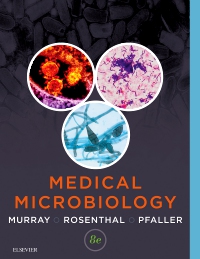
Medical Microbiology E-Book, 8th Edition
Paperback

-
- Coverage of basic principles, immunology, laboratory diagnosis, bacteriology, virology, mycology, and parasitology help you master the essentials.
- Review questions at the end of each chapter correlate basic science with clinical practice to help you understand the clinical relevance of the organisms examined.
- Clinical cases illustrate the epidemiology, diagnosis, and treatment of infectious diseases, reinforcing a clinical approach to learning.
- Full-color clinical photographs, images, and illustrations help you visualize the clinical presentations of infections.
- Summary tables and text boxes emphasizing essential concepts and learning issues optimize exam review.
- Additional images, 200 self-assessment questions, NEW animations, and more.
-
- Thoroughly updated chapters include the latest information on the human microbiome and probiotics/prebiotics; including a new chapter on Human Microbiome In Health and Disease
- NEW chapter summaries introduce each microbe chapter, including trigger words and links to the relevant chapter text (on e-book version on Student Consult), providing a concise introduction or convenient review for each topic.
- Full-color clinical photographs, images, and illustrations help you visualize the clinical presentations of infections.
- Additional images, 200 self-assessment questions, NEW animations, and more.
-
SECTION 1
Introduction
1 Introduction to Medical Microbiology
2 Human Microbiome in Health and
Disease
3 Sterilization, Disinfection, and
Antisepsis
SECTION 2
General Principles of Laboratory
Diagnosis
4 Microscopy and In Vitro Culture
5 Molecular Diagnosis
6 Serologic Diagnosis
SECTION 3
Basic Concepts in the Immune
Response
7 Elements of Host Protective
Responses
8 Innate Host Responses
9 Antigen-Specific Immune Responses
10 Immune Responses to Infectious
Agents
11 Antimicrobial Vaccines
SECTION 4
Bacteriology
12 Bacterial Classification, Structure, and
Replication
13 Bacterial Metabolism and Genetics
14 Mechanisms of Bacterial
Pathogenesis
15 Role of Bacteria in Disease
16 Laboratory Diagnosis of Bacterial
Diseases
17 Antibacterial Agents
18 Staphylococcus and Related Gram-Positive
Cocci
19 Streptococcus and Enterococcus
20 Bacillus
21 Listeria and Related Gram-Positive
Bacteria
22 Mycobacterium and Related Acid-Fast
Bacteria
23 Neisseria and Related Genera
24 Haemophilus and Related Bacteria
25 Enterobacteriaceae
26 Vibrio and Related Bacteria
27 Pseudomonas and Related Bacteria
28 Campylobacter and Helicobacter
29 Miscellaneous Gram-Negative Rods
30 Clostridium
31 Non–Spore-Forming Anaerobic
Bacteria
32 Treponema, Borrelia, and Leptospira
33 Mycoplasma and Ureaplasma
SECTION 1
Introduction
1 Introduction to Medical Microbiology
2 Human Microbiome in Health and
Disease
3 Sterilization, Disinfection, and
Antisepsis
SECTION 2
General Principles of Laboratory
Diagnosis
4 Microscopy and In Vitro Culture
5 Molecular Diagnosis
6 Serologic Diagnosis
SECTION 3
Basic Concepts in the Immune
Response
7 Elements of Host Protective
Responses
8 Innate Host Responses
9 Antigen-Specific Immune Responses
10 Immune Responses to Infectious
Agents
11 Antimicrobial Vaccines
SECTION 4
Bacteriology
12 Bacterial Classification, Structure, and
Replication
13 Bacterial Metabolism and Genetics
14 Mechanisms of Bacterial
Pathogenesis
15 Role of Bacteria in Disease
16 Laboratory Diagnosis of Bacterial
Diseases
17 Antibacterial Agents
18 Staphylococcus and Related Gram-Positive
Cocci
19 Streptococcus and Enterococcus
20 Bacillus
21 Listeria and Related Gram-Positive
Bacteria
22 Mycobacterium and Related Acid-Fast
Bacteria
23 Neisseria and Related Genera
24 Haemophilus and Related Bacteria
25 Enterobacteriaceae
26 Vibrio and Related Bacteria
27 Pseudomonas and Related Bacteria
28 Campylobacter and Helicobacter
29 Miscellaneous Gram-Negative Rods
30 Clostridium
31 Non–Spore-Forming Anaerobic
Bacteria
32 Treponema, Borrelia, and Leptospira
33 Mycoplasma and Ureaplasma
34 Rickettsia, Ehrlichia, and Related
Bacteria
35 Chlamydia and Chlamydophila
SECTION 5
Virology
36 Viral Classification, Structure, and
Replication
37 Mechanisms of Viral Pathogenesis
38 Role of Viruses in Disease
oplasma and Ureaplasma
34 Ricke

 as described in our
as described in our 